
The Bromeliaceae is a family of monocot flowering plants of 75 genera and around 3590 known species native mainly to the tropical Americas, with a few species found in the American subtropics and one in tropical west Africa, Pitcairnia feliciana.

Bromelia is the type genus of the plant family Bromeliaceae, subfamily Bromelioideae. Bromelia species are widespread across much of Latin America and the West Indies, and are characterized by flowers with a deeply cleft calyx. The genus is named after the Swedish medical doctor and botanist Olof Bromelius (1639-1705).

Fosterella is a genus of plants in the family Bromeliaceae, subfamily Pitcairnioideae. It contains 31 recognized species, 30 native to central and western South America, one to Mesoamerica. The genus is named after Mulford B. Foster, American horticulturist and collector (1888-1978).

Araeococcus is a genus of the botanical family Bromeliaceae, subfamily Bromelioideae. It is native to northern South America, Central America and Trinidad.

Billbergia is a genus of flowering plants in the family Bromeliaceae, subfamily Bromelioideae. The genus, named for the Swedish botanist, zoologist, and anatomist Gustaf Johan Billberg, is divided into two subgenera: Billbergia and Helicodea. They are native to forest and scrub, up to an altitude of 1,700 m (5,577 ft), in southern Mexico, the West Indies, Central America and South America, with many species endemic to Brazil.

Canistrum is a genus of plants in the family Bromeliaceae, subfamily Bromelioideae.
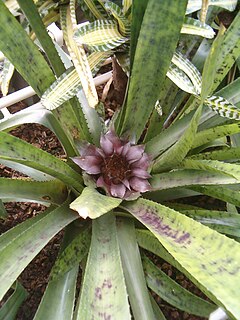
Wittrockia is a genus of plants in the family Bromeliaceae, subfamily Bromelioideae.

Orthophytum is a genus in the plant family Bromeliaceae, subfamily Bromelioideae.
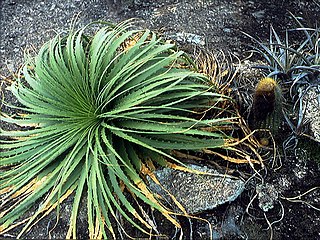
Encholirium is a genus of plants in the family Bromeliaceae, subfamily Pitcairnioideae. The entire genus is endemic to Brazil. The genus name is from the Greek “enchos” (spear) and “leiron” (lily).
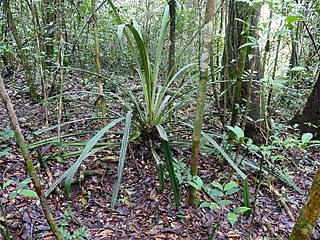
Disteganthus is a genus of plants in the family Bromeliaceae, subfamily Bromelioideae. The genus name is from the Greek “dis” (two), “steg” (covering), and “anthos” (flower). They are considered a primitive genus among bromeliads and are only found in terrestrial environments. Distenganthus has three known species, native to northeastern South America.

Hohenbergia is a genus of plants in the family Bromeliaceae, subfamily Bromelioideae. It is native to the West Indies, the Yucatán Peninsula, and northern South America.

Greigia is a genus of plants in the family Bromeliaceae, subfamily Bromelioideae. It is native to Latin America from Mexico to Chile. The genus is named in honour of Major General Samuel Alexjewitsch Greig, president of the Russian Horticultural Society in 1865.
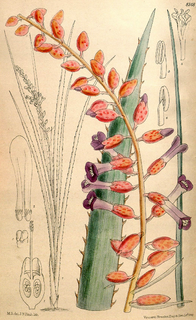
Neoglaziovia is a genus in the plant family Bromeliaceae, subfamily Bromelioideae.

Nidularium is a genus in the plant family Bromeliaceae, subfamily Bromelioideae. Named to describe the nestling characteristic of the inflorescence, all the species are endemic to Brazil. Commonly confused with Neoregelia which they resemble, this plant group was first described in 1854.
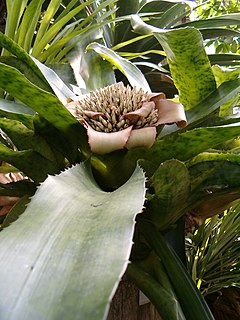
Edmundoa is a genus of plants in the family Bromeliaceae, subfamily Bromelioideae. The genus is named for Edmundo Pereira, Brazilian botanist (1914–1986) and has only recently been recognized as an independent genus, grouped earlier with Canistrum.

Ronnbergia is a genus in the plant family Bromeliaceae, subfamily Bromelioideae. Native to South and Central America, this genus was named for Auguste Ronnberg, Belgian Director of Agriculture and Horticulture in 1874.

Alcantarea is related to the genus Vriesea of the botanical family Bromeliaceae, subfamily Tillandsioideae.

Canistropsis is a genus of plants in the family Bromeliaceae, subfamily Bromelioideae.
Pseudaechmea is a genus of the botanical family Bromeliaceae, subfamily Bromelioideae. The genus name is from the Greek “pseudos” (false) and the genus Aechmea. The genus was established by Lyman Smith and R.W. Read in 1982.
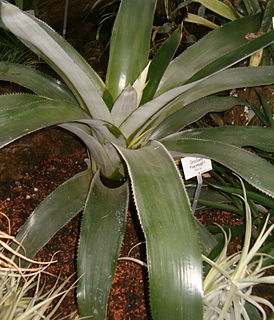
Ursulaea is a genus in the plant family Bromeliaceae, subfamily Bromelioideae. Represented by two known species, these plants are endemic to Mexico.



















